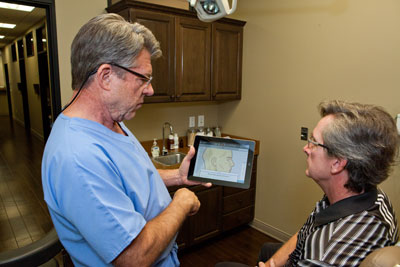Dermatology
Below is a listing and description the common skin disorders treated at McCray Dermatology. As with any skin condition, an in-person examination is required to make a definitive diagnosis and treatment plan.
Acne: The primary skin lesion in acne is the comedo, a pore that becomes blocked by too much oil, or sebum, that is being secreted by that pore’s oil gland.
Acne Keloidalis Nuchae: This is a skin condition characterized by are small, firm, reddish-purple bumps on the back of the neck, usually in people of darker skin types.
Actinic Keratosis: Actinic keratoses (AKs) are precancerous lesions commonly seen on the face, scalp, forearms, and backs of the hands as a result of chronic sun exposure. See Skin Cancer page.
Actinic Chelitis: A precancerous condition of the lips due to chronic sun exposure.
Age spots (Lentigenes): Extensive sun exposure can cause brown spots (known medically as lentigenes) of various shapes and sizes most commonly on the face, chest, forearms, and backs of the hands.

Alopecia (Hair Loss): Both men and women can suffer from hair loss of many different causes. For men, the most important type is called androgenetic alopecia, thinning caused by genetically determined sensitivity of hair follicles to testosterone, the male hormone.
Alopecia Areata: This is a type of hair loss that usually is characterized by one or two round bald spots with no associated symptoms.
Angiofibroma: Angiofibromas, also called fibrous papules, are skin-colored to slightly red, small, round bumps that are usually seen on the face, especially the nose.
Atypical Nevus: A nevus is the medical term for a mole; an atypical nevus is an abnormal mole that may be considered pre-cancerous in that it may have a higher risk than a normal mole of developing melanoma skin cancer.
Basal Cell Carcinoma (BCC): The most common form of cancer. It affects a little less than 1 million people in the US annually. See Skin Cancer page.
Bowen’s Disease: A superficial form of the type of skin cancer known as squamous cell carcinoma.
Broken Blood Vessels (Telangectasia): Dilated or “broken” blood vessels, also called telangectasias, are small red veins seen in fair-skinned individuals on the face, especially around the nose.
Brown Spots/ Facial Discoloration: Diffuse facial brown spots are usually associated with sun exposure and can be one of the earliest signs of aging. Many occur after childbirth or while on birth control pills.

Cherry Angiomas (Hemangiomas): These are little bright red bumps on the body that increase in number over time. They are common on the trunk, arms, and legs, but are less common on the face.
Compound Nevus: A compound nevus is a benign (non-cancerous) mole that is usually raised and light tan to dark brown in color.
Contact Dermatitis: The classic example of acute contact dermatitis is the blistering, oozing, itchy rash from skin contact with poison ivy, oak or sumac.
Cysts: Common skin growths characterized by an under the skin lump that can sometimes become ruptured and inflamed.
Dermatofibromas: Brown, hard bumps that can sometimes mimic moles and are often of concern to patients. Some are red and inflamed but all share the features of a round shape and very firm texture.
Dermatosis Papulosa Nigra: A skin condition characterized by tiny dark brown or black “wart-like” growths on the face, neck, and chest of patients, usually those of darker skin type.
Dry Skin (Xerosis): Known medically as xerosis, is seen commonly during the winter months when the air is cold and humidity is low.
Eczema (Atopic Dermatitis): Patients with eczema or atopic dermatitis are often described as having skin that is itchy, dry, sensitive, and easily irritated.
Enlarged Pores: Genetics and aging are the two main factors that contribute to large pores. Unfortunately, there is no way to permanently shrink enlarged pores.
Ethnic Skin: Some people with Asian, Middle Eastern, African-American, Indian, Native American and Mediterranean backgrounds can look pale or light in skin color.
Excessive Sweating (Hyperhidrosis): Excessive sweating can involve the face, underarms, hands, and feet.
Hand Eczema: Dry, red, scaly patches of skin occur on the fingers, web spaces, and backs of the hands in patients with hand eczema. Another type of hand eczema causes small, itchy blisters, especially on the sides of the fingers.
Herpes Simplex: Herpes simplex virus type 1 is the cause of cold sores around the mouth while genital herpes is usually caused by herpes simplex virus type 2 infection.
Hives (Urticaria): Known medically as urticaria, are very itchy red welts on the body. These raised inflamed patches can come and go quickly and move to new areas of the body rapidly. Most cases of hives, while uncomfortable, are not serious, and last for a few days to a few weeks.
Genital Warts: A sexually transmitted disease caused by infection with the human papilloma virus (HPV), genital warts are characterized by the presence of skin colored to tan bumps with a convoluted surface.
Granuloma Annulare: The red, round lesions of granuloma annulare, seen most commonly on the backs of the hands and feet, are often mistaken for ringworm fungus.
Impetigo: A superficial bacterial infection of the skin, usually caused by staphylococcus aureus. It usually is characterized by a yellow, crusted, oozing area of the skin with some redness.
Intradermal Nevus: This is a skin colored, raised mole that has usually been present for a long time and has slowly become more protuberant over time. Intradermal nevi are harmless and usually are removed only if they become irritated by clothing or by shaving.
Junctional Nevus: This type of mole is common in younger people and looks like a flat pigmented spot that is usually darker in color than freckles and sun spots.
Keloids: An abnormal type of healing response in which the scar tissue overgrows beyond the margins of the wound. These often appear as hard, inflamed lumps that are itchy or tender.
Keratosis Pilaris (KP): The medical term for unsightly tiny, scaly, red bumps on the back of the arms and sometimes on the thighs.
Lichen Planus (LP): An itchy skin condition characterized by flat-topped, smooth bumps classically appearing on the wrists.
Lentigo (Liver Spots): A telltale sign of aging, so called “liver spots” are brown spots that have nothing to do with the liver. Lentigos are most commonly seen on the forearms and backs of the hands and are associated with chronic sun exposure.
Milia: Small white bumps, non-inflamed white heads, commonly seen on the face in women.
Moles (Nevi): Collections of melanocytes, the pigment producing cells present in the skin.
Melanoma: A serious form of skin cancer that arises from the pigment cells of the skin known as melanocytes. See Skin Cancer page.
Melasma: The “mask of pregnancy”, is a sharply demarcated darkening of the face, especially over the cheeks, forehead and upper lip.
Molluscum Contagiosum (MC): A viral infection of the skin common in both adults and children. MC lesions look like tiny skin-colored bumps that increase in number over several weeks or months.
Nail Fungus: Nail fungus involving several toenails can be seen commonly in people who also have fungus on the feet, between the toes, and in the groin.
Perioral Dermatitis: A condition of small, dry, acne-like bumps around the mouth.
Pityriasis Alba: One of the skin manifestations of eczema or atopic dermatitis. Typically, the patients are children of darker skin type who develop indistinct, slightly scaly white spots over the face and upper arms.
Pityriasis Rosea: A red rash that usually starts with one large, round spot on the torso which later spreads to become a truncal rash characterized by oval scaly patches.
Pseudofolliculitis barbae (PFB): A condition also known as “razor bumps”, “shaving bumps” or “ingrown hairs”.
Psoriasis: A genetic immune system disorder that leads to the development of thick, inflamed, red skin patches with overlying white scale.
Pruritus: Pruritus, or itch, is defined as a unpleasant sensation that provokes the desire to scratch. Dry skin is one of the most common causes of pruritus.
Pyogenic Granuloma: A pyogenic granuloma is rapidly growing, inflamed bump that typically needs to be covered by a bandage as it bleeds profusely. Read More…
Ringworm: A fungal infection of the superficial layer of the skin. Fungi penetrate and begin to proliferate within the skin causing the characteristic expanding red, scaly, ring-shaped rash.
Rosacea: There are several forms of rosacea; acne-like, red bumps of the cheeks and nose, diffuse facial redness, and dilated capillaries are common features.
Scabies: Microscopic mites that burrow under the skin causing a very itchy and infectious skin condition. People living in close proximity such as students, military or nursing home residents are especially at risk.
Sebaceous Gland Hyperplasia: A condition of small, yellow-colored facial bumps often with a central depressed pore.
Seborrheic Dermatitis: A common condition similar to dandruff. It affects the scalp, face (around the nose and eyebrows), behind the ears and sometimes the center of the chest.
Seborrheic Keratosis (SK): A common, benign (not associated with cancer) skin lesion commonly found on the face or trunk. It is rough, scaly, and often “greasy and stuck on” in its clinical appearance.
Shingles (Herpes Zoster): Represents a reactivation of past infection with the chickenpox virus. This virus never completely clears the body but instead lives inside the nerves and can travel to the skin at times of stress or illness to cause a shingles outbreak.
Skin Cancer: There are three major types of skin cancer, all of which are common in fair skinned individuals who have had extensive sun exposure in the past: basal cell carcinoma, squamous cell carcinoma, and melanoma. See Skin Cancer page.
Skin Tags: These are skin colored or brown soft bumps that are commonly seen in areas of chronic friction; underarms, neck, inner thighs, and eyelids are common locations.
Squamous Cell Carcinoma (SCC): The second most common form of skin cancer after basal cell carcinoma (BCC). SCC is more serious than BCC because SCC does have the ability to metastasize, or spread to other areas of the body. See Skin Cancer page.
Tinea Versicolor: A fungal infection of the skin that is characterized by the development of white, tan, or slightly inflamed patches on the trunk.
Warts: Caused by a viral infection (human papilloma virus) in the epidermis
Office Hours
Both McCray Dermatology offices are open Monday through Friday.
Please call for hours because they are subject to change.
Valencia (661) 254-7200 or
Palmdale (661) 947-3700

